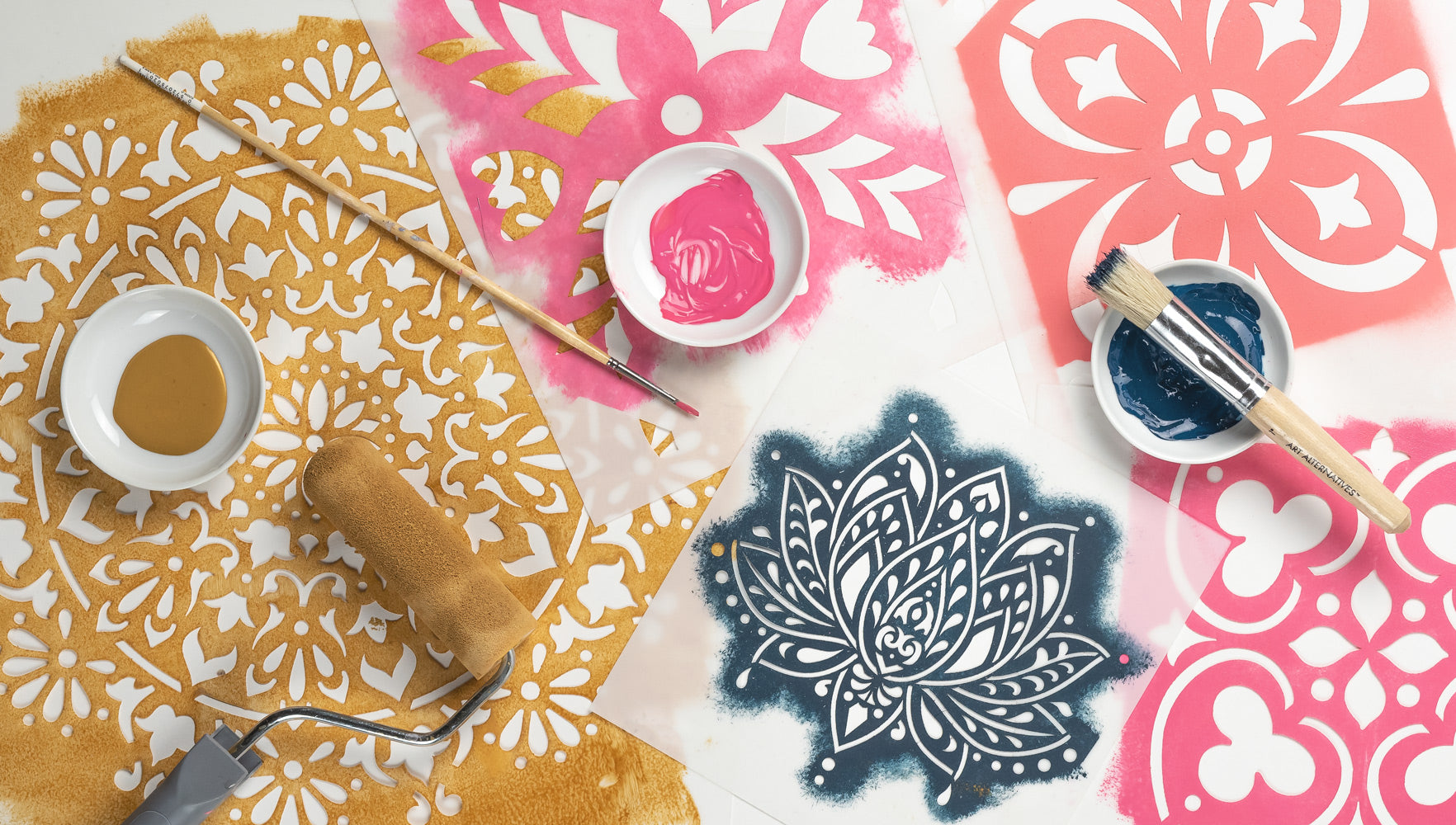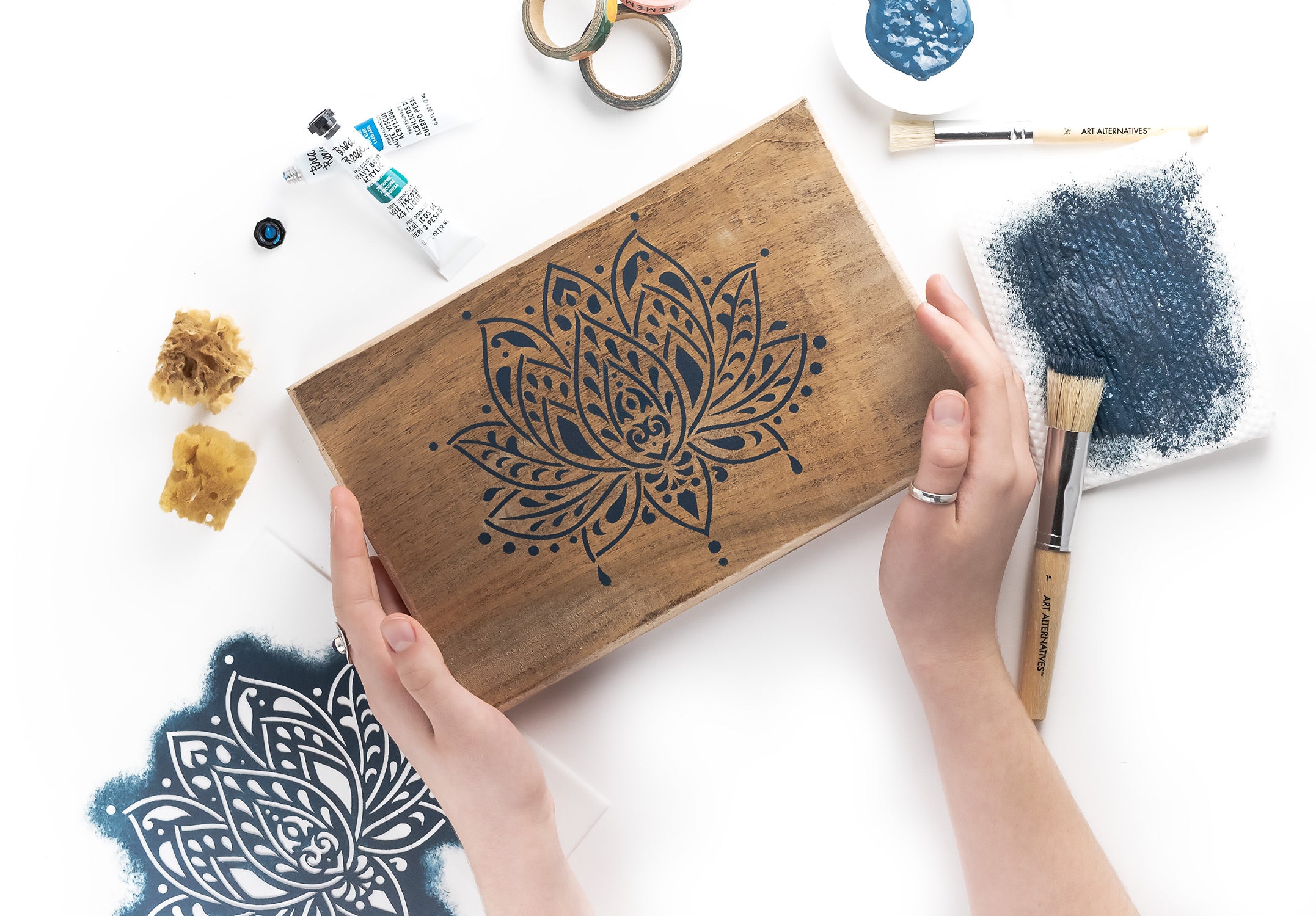
How to Stencil Like a Pro: A Beginner's Guide
Learning how to stencil is a fabulous way to bring out your inner-artists and create a unique handcrafted finish on any surface: walls, floors, furniture, wood, metal, paper, fabric.
Stencilling is easy as it is fun and inspires a feeling of creative satisfaction. Pieces made by hand have a certain charm and a vibe that is undeniable; a quality that store-bought art cannot compete with. Not to mention, stencils are economical. You can reuse a quality mylar stencils many times with simple care and proper storage. Whipping up a design that looks amazing for a fraction of the cost is just a dab (or roll) of paint away.
One word of advice: embrace your inner-artist but let go of your inner-critic. Seriously. The magic of stencilling is the hand-painted finish. There will be tiny imperfections. Expect it and let it go. Our eyes will see motifs and pattern not by individual flaw.

Tools + supplies
- Application tool: brush, dabber, sponge, or roller.
- Adhesive: Painter's tape or Spray Adhesive.
- Paint: Acrylic ( matte), chalk paint, stencil creme.
- Paint Tray: to hold paint or blend and create custom colors.
- Paper towel or Rags: To offload the paint before stencilling.
- Ruler/Tape measure: Measure and align the artwork.
- Stabilizer ( optional): Dowel, Pencil, or any stick-like tool.
- Stencils: If you need a stencil, we have tons of awesome designs! Our wall stencils and mandala stencils are some of the most popular.
Texture is important
You can stencil on almost anything, but not everything, like rough or heavily textured surfaces. Because the stencil cannot lay flat on a textured surface, the paint will bleed underneath areas that do not contact the surface.
Be sure to sand down rough textured wood, or scrape and sand any loose or cracked paint before you begin. The smoother, the better.
Prep the surface before you start
Every time, every project!By not preparing the surface beforehand, you run the risk of a failed project. Stencilling over an unprepared surface ( dirt, dust, oil, old paint) it is like building a house on a sand hill. All that work will slide or peel off.
Removing loose paint, dirt, or oil with a quick wipe down with a cleaning solution will help the paint stick to the surface — no need to buy fancy store-bought cleaner. A mild soap and water wipe is all you need for most hard surfaces. If you need a deeper clean, we’ve included two non-toxic recipes using ingredients most households have on hand.
Simple Cleaning Solution
- 1 cup of water
- 1 cup vinegar
Mix water and vinegar, that’s it! These are simple mixtures you can use to wipe down walls, furniture, floors without having to rinse. Wipe and go.
Deep Cleaning Solution
- 1 cup of water
- ½ cup of vinegar
- 1-2 tsp Borax
Wood: Use medium-fine grit sandpaper to smooth and create a good base. Wash with cleaning solution and let dry.
Metal: Wash with a cleaning solution and let dry. For a metal with rust, give it a good scrub with vinegar and baking soda to remove any loose bits. Wash with cleaning solution and let dry.
Walls + Furniture: Remove loose or cracked paint by lightly scraping or sanding the surface. Wash with cleaning solution and let dry.
** Sanding will take the finish off previously painted surface. These are excellent steps to take before priming and painting.
Fabric: Wash and dry fabric. Skip the fabric softener because it creates a barrier between the material and paint.
Glass/Ceramics: Wash with a cleaning solution and let dry.
How to stencil without bleed

Learning how to stencil without bleed is the key to a crisp edge. Don’t go slapping the paint around willy-nilly. There are a few tips and tricks to get successful results each time.
Ready?
Tip 1: Stabilize the stencil
Use painter’s tape or spray adhesive to secure the stencil to the surface, so it doesn’t move.
Spray adhesive will guarantee security that the stencil won’t move, or the brush won’t catch the edge and result in paint bleed underneath. Lightly spray adhesive to the back of the stencil and position on the surface.
Remove any residue from spray adhesive with a damp paper towel, or using one of the cleaning solutions used to prep the surface. Being 100% honest, removing all the spray adhesive is hard. There will be some of the spray adhesive that will be left behind. It won’t ruin the stencil. After you clean the stencil, place it on a piece of wax or parchment paper before storing the stencil. These steps hold true regardless if you're learning how to stencil on wood or any other surface. Keeping a clean stencil is crucial if you want it to have a long life.
When using painter’s tape, make sure you tape all sides, including corners ( if you can). A dowel or a pencil end is handy to hold the stencil down in the area you are painting because it prevents the stencil from lifting while you paint.
Tip 2: Offload and work in layers
If there were a golden rule for how to stencil, this would be it - offload the paint. Every dip in the paint. Every time.
Offloading means removing the excess paint from the applicator onto a paper towel or rag. The brush should be almost dry to the touch. A little paint goes a long way.
This method is called dry brushing.
The trick is to use a dry brush (or roller) and work in layers. Slowly building up the color will result is a clean and professional finish.
*Tools: stipple brush, dabber, sponge, or roller.
Tip 3: Tap tap tap that paint
Apply paint at the edges of the stencil and work towards the center with a light up-and-down motion ( tap tap tap). Avoid using a side-to-side movement or pressing too firm; this will cause bleed.
Naturally, if you are using a foam roller, you won’t use an up-and-down motion. But you still want to start from the edges of the stencil and work towards the middle.
*Tools: stipple brush, dabber, sponge.
Tip 4: Patience
The finish is exciting. You want to peek and see, but trust me, don’t. Wait a few minutes for the paint to dry, then lift the stencil. Wet paint around the edge of the stencil can bleed or drip when lifting the stencil off the surface. It’s worth the extra few seconds to be patient.

Touch up
Ok, so you’re finished, and you lift the stencil, and everything is perfect except one (or two spots).
Blergh!
Don’t sweat it! It’s fixable.
Grab a small paintbrush and give it a light touch up with the base color. No one will notice!

Stencil Tip - Mend those bridges
Bridges are the connectors (tabs) that hold the stencil together and give it strength. Without bridges, the graphic would be one big outline with no detail.

*This design is from our floor tile stencils collection, they're great for DIY projects.
Some people like the bridged look and others don’t. It’s really up to you. Lettering or sayings sometimes read easier without the bridges.
After you have finished painting the stencil, grab a brush and fill in the gaps ( bridges), and Voila!

Caring for your stencil
It’s important to clean and store your stencil correctly so that it can be reused across multiple projects, and provide a crisp line with each use. We’ve created a guide to cleaning and caring for your stencils.
Happy stencilling!

Comments
Leave a comment